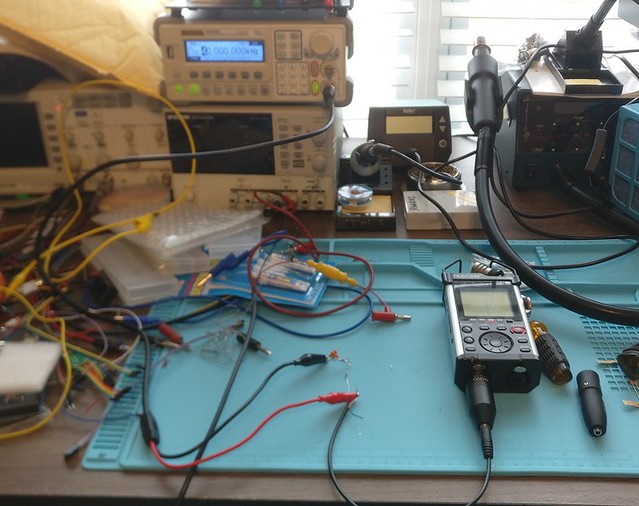TRS to XLR Adapter Frequency Response
Written 2021-12-30
Tags:XLR microphone audio
I've got a couple TRS microphone to phantom power XLR adapters, one Rode VXLR+ and Move F-XLR Pro. The Rode has a better housing and interoperability with my equipment, so it's already my favorite, but I was curious about their frequency responses and if there were any band limits.
Test Setup

- Rigol DG1022 DDS waveform generator emitting 100mVPP sine waves, 50Ohm source
- 6uF capacitor, 1kOhm resistor in series
- TRRS pigtail, select leads according to TRS/XLR adapter under test
- Tascam DR-44WL audio recorder in 96KHz 24bit WAV mode, using first XLR input
- Step through each frequency, dwelling several seconds
Analysis
For each tone, I selected the relevant segment in Audacity's spectrogram view:
Once a tone is selected, I used analysis->plot spectrum to bring up an FFT of only the selected interval. I used a Hann window and 65536 points, though this image shows a 4096 point, as the 65536 point FFT pixels are smaller than display pixels and become hard to see.
Then I selected the peak frequency and amplitude and saved to a spreadsheet.
Because of the DDS generator, I did not try to measure SNR. SNR through these adapters is interesting, as they use a Zener diode and resistors to conver the 48V phantom power to 3-5v microphone power, but in doing so, emit some noise or hiss, and the selection of Zener diode becomes quite important. Kamil's tech tips found the Movo to be around 7dB noisier than the Rode. I might look at noise floor separately later.
Results
The Rode and Movo adapters have eerily similar response curves. It turns out that they are largely the same design with a slightly different wiring, so this actually makes sense. Zach Poff has an explanation and reverse engineered schematic here.
The low end is fine for speech and the high end actually extends a bit past nyquist(48KHz here) and aliases back in the spectrogram - I'm not sure if the adapters are limiting it or an anti-aliasing filter inside the Tascam recorder. Make no mistake, this roll-off is necessary and important, but if I were making my own adapter, it might make sense to move the cut-off even lower
Error Analysis
- The AC coupling of my signal source has an implicit high-pass filter effect, and it's quite possible the high-pass filter is limiting the low-end response. I can confirm some degree of this with my oscilloscope showing voltage across the capacitor.
- My signal generator is of the DDS type, which shows odd, but quiet noises. These were on differing frequencies, so I was able separate them spectrally, so I don't think this should impact things much.
- These results likely aren't directly comparable to anyone else's, but JEITA CP-2150 isn't publicly available.
- There's a bunch of other electronics on my desk, and my test wasn't shielded.
- The flatness of the signal generator is 0.1dB under 100kHz, should be fine.


